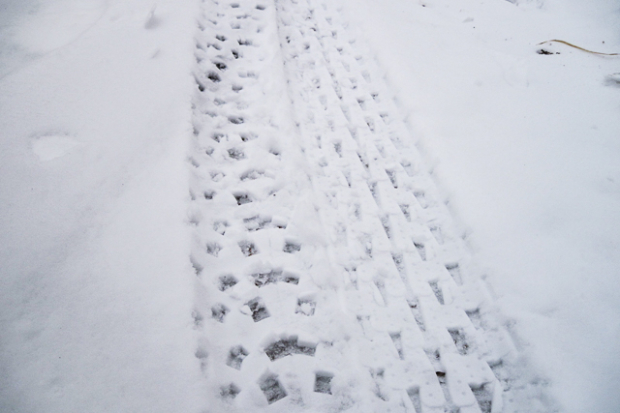Winter is upon many of our readers, so we thought it was the perfect time to continue our tubeless wheel and tire coverage with some relevant cold-weather information. What exactly should you do with your tubeless wheels and tires during the winter? Must you revert back to inner tubes? Are there any special procedures, sealants, or other considerations? We’ll dive right in – splitting our discussion into two sub-categories: 1) Storing tubeless wheels that will not be used during the winter, and 2) Riding tubeless wheels through the winter season.

Storage of Tubeless Wheels and Tires for the Winter
Let’s say that your triathlon bike – or perhaps the race wheels for your tri bike – will sit idle for five or six months during the winter. If your wheels and tires have inner tubes, they’ll simply go flat over time, without any real care or feeding necessary. If you have tubeless wheels and tires however, allowing them to go completely flat could result in the tire beads coming unseated – causing a liquid sealant mess in your garage or wheel bags. That means that there are two key routes to take for winter tubeless wheel storage: either keep them pumped up – or completely remove the tires for storage.

Personally, I prefer to set a reminder in my calendar to pump the tires up once per month. Upon doing so, I’ll pump them to the maximum pressure that the rims and tires will allow – helping to ensure that they stay inflated as long as possible. At this time, I also give the wheels a hard spin, to mix up the tire sealant and prevent it from forming a solid dried chunk. Note that once a month isn’t really enough to avoid all chunk formation, and you will still want to remove and clean the tires at least once per year. If you want to be extra careful, a weekly spin should be sufficient for keeping the sealant mostly mixed up.
Option B is to deflate, remove, and clean the tires. I recommend removing the sealant ahead of time using the KOM Cycling Sealant Tool (THIS article has a video showing how it works) - an inexpensive device that will eliminate much of the potential mess. Clean the wheels and tires thoroughly with a rag and cleaning spray of your choice. I prefer Simple Green Bike, which seems to work well without being harsh on rubber. There’s no secret method here, and all you do is wipe away any and all sealant, semi-dried slurry, dried sealant chunks, and any other dirt or grease. Also take this opportunity to closely inspect the tire for cuts, wear, or other damage.

Note that some sealant manufacturers recommend cleaning out the inside of your tires with soap, water, and a stiff brush – especially if you plan on using a different type or brand of sealant later (different sealants don’t often mix well). This will obviously require extra work, so I stick to my quick-and-easy method mentioned above. Store extra bottles of sealant indoors, so it doesn’t become a frozen block. Also, you shouldn’t be buying large quantities of sealant in the first place, because most sealants have a shelf life of about a year.
Riding Tubeless Wheels and Tires in the Winter

If your winter bike has tubeless wheels and tires, it’s entirely possible to ride them through the winter. It might be a gravel bike, a mountain bike, a fat bike – or whatever suits you best. The only hitch is that if your area gets enough snow and ice to warrant studded tires, there aren’t a tremendous amount of options (though more are emerging, such as the Dillinger tubeless-ready fat bike tire from 45NRTH). I’ve ridden a few studded gravel/cyclocross tires in the past, and they’re usually thick and heavy, often with stiff wire beads – and are recommended for use with inner tubes.
Studded tires aside, there aren’t many other special considerations. Perhaps the most important is that cold weather increases the importance of a good rim/tire fit. If your rims and tires fit together absurdly tight, and you get a flat tire that doesn’t seal successfully via the tire sealant, it can get downright dangerous to be stranded (trying to remove the tire with freezing hands). It’s much better to have a rim and tire that fit together somewhat loose, and will allow you to install an inner tube in the case of a bad puncture.

Also be sure to check with your tire sealant manufacturer for recommended operating temperatures. There are even some specialty sealants out there, such as the Subzero formula from Orange Seal. It’s made specifically for winter riding, and prevents freezing into a solid block. Regardless of sealant type, don’t skimp on the volume, because you want to give yourself every chance of having those punctures seal – see the reasons above about being stranded with freezing hands.

My final piece of advice doesn’t relate specifically to tubeless tires. Simply put: Winter is the time to check your equipment thoroughly before you venture out to ride. If you aren’t handy with wrenches, take your bike(s) in for a tune up before problems force you to do so. Always err on the side of simplicity and durability, because keeping yourself moving (and rubber-side-down) is what it’s all about.



